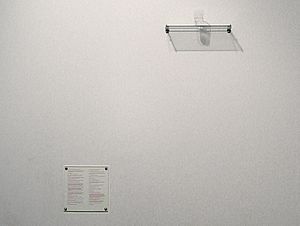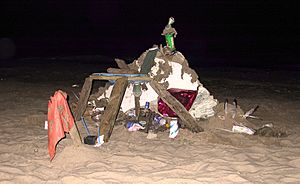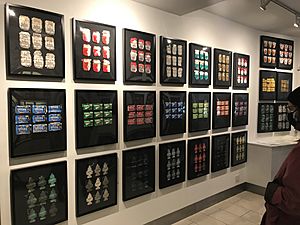Found object facts for kids
Found art (also called a found object) is a type of art. It is made from everyday items or products that are not usually seen as art materials. These items often have a different purpose in real life. Artists choose these objects and present them as art.
One of the first artists to use this idea was Pablo Picasso. In 1912, he glued a printed image of chair caning onto his painting called Still Life with Chair Caning. Later, Marcel Duchamp took this idea further. He created "ready-mades." These were ordinary objects that he chose and simply called art, without changing them much. His most famous ready-made is Fountain (1917). It was a regular urinal from a hardware store, placed on a stand.
Found objects become art because the artist says they are art. Also, their history or how they look (like being worn out) can make them interesting. The place where the art is shown is also important. At first, showing everyday things as art was very shocking. It made people question what art really was. Even today, it can make people think deeply about objects. They might feel different emotions, from surprise to a sense of memory.
When an artist uses a found object, they usually give it a title. This helps us understand their idea. Sometimes, the artist changes the object a little, but often you can still tell what it was originally. Some people believe that just choosing an object and moving it changes how we see it. This makes it a new kind of object, even if it looks the same.
Contents
History of Found Art
Early Ideas
Some art experts think that scholar's rocks from East Asia are early examples of found objects. These special rocks are found in nature. They are changed very little, maybe just given a stand to sit on. People look at them to think about nature. Their unique shapes come from natural processes like erosion, not from an artist carving them.
In the late 1800s, a French expert found some old artworks. One of them was a green carriage curtain hanging from a wooden stick. This piece was likely shown in Paris between 1883 and 1893. Some believe it might be the oldest known ready-made. It could have even inspired Marcel Duchamp later on.
Duchamp's "Ready-mades"
Marcel Duchamp created the term ready-made in 1915. He used it to describe a common object he chose without changing it. For example, in 1913, Duchamp put a bicycle wheel on top of a stool. He called this Bicycle Wheel.
In 1917, Duchamp's Fountain caused a big stir in the art world. It was a urinal signed with the name "R. Mutt." Duchamp later wrote that a female friend helped him come up with the idea for this work. Some historians think this friend might have been Elsa von Freytag-Loringhoven or Louise Varèse.
Some research suggests that Duchamp might have actually made some of his "found" objects himself. For example, the urinal in Fountain might not have been a regular, working urinal. However, other stories say that Duchamp bought the original Fountain from a store.
How Found Art Grew

The idea of using found objects quickly became popular with the Dada art movement. Artists like Man Ray and Francis Picabia used them. Man Ray made a famous work called Gift (1921). It was an iron with nails sticking out of its bottom, making it useless. Other artists started combining several found objects. This type of art is sometimes called an assemblage. Duchamp also made an assemblage called Why Not Sneeze, Rose Sélavy?. It was a birdcage with a thermometer and 151 marble cubes that looked like sugar.
By the 1930s, artists had many different types of found objects. The Surrealist leader, André Breton, said that ready-mades were "manufactured objects raised to the dignity of works of art through the choice of the artist."
In the 1960s, found objects were used in the Fluxus movement and pop art. Joseph Beuys showed modified found objects, like rocks with fur and fat stuffed into holes. In 1973, Michael Craig-Martin made a work called An Oak Tree. He said a glass of water was an oak tree. He explained that he changed the glass of water into an oak tree, even though its appearance stayed the same.
Other Kinds of Found Art
Commodity Sculpture
In the 1980s, a new type of found art appeared called commodity sculpture. Artists would arrange everyday, mass-produced items in art galleries. The main idea was to focus on how products are marketed and displayed. Artists like Jeff Koons and Haim Steinbach created these works.
One of Jeff Koons' early famous pieces was Two Ball 50/50 Tank (1985). It was a glass tank half-filled with water, with two basketballs floating in it.
Trash Art

A special kind of found art is called trash art or junk art. These artworks are mostly made from discarded items, often literally from the trash. One example is "trashion," which is fashion made from trash. Artist Marina DeBris collects trash from beaches and turns it into dresses and other clothes. Many groups hold competitions for junk art. Trash art can also help people think about how much trash we create.

Some artists who create art from trash include:
- Spanish artist Francisco de Pajaro, who says "Art is trash."
- Australian artist Paul Yore, who uses trash to challenge people's ideas about taste and too much buying.
In Music
Found objects can also be used to make music! This is an important part of a music style called musique concrète. In this style, artists use recorded sounds from the real world.
Musicians like Radiohead and Björk have used found sounds in their songs. The musician Cosmo Sheldrake uses sounds from nature in his music. He believes that using sounds from ecosystems can help share important messages about things like climate change.
Debates About Found Art
Found art has caused many debates, especially in Britain during the 1990s. Some people, like the public and journalists, did not like it. But art museums and critics often supported it.
In 2000, a museum director named Sir Nicholas Serota spoke about "difficult" art. He mentioned how some newspapers criticized modern art, saying things like "pickled sheep and soiled beds threaten to make barbarians of us all." This was a reaction to works like Tracey Emin's My Bed, which was her unmade bed with clothes around it.
In 1999, some artists who used to work with found objects started a group called the Stuckists. They said that ready-made art was too focused on materials. They wanted to go back to painting instead.
Artists Who Use Found Objects
Many modern artists are known for using found objects in their art. Here are some of them:
- Saâdane Afif
- Arman
- Joseph Beuys
- Guillaume Bijl
- George Brecht
- Jake and Dinos Chapman
- Joseph Cornell
- Tony Cragg
- Salvador Dalí
- Marina DeBris
- Jim Dine
- Marcel Duchamp
- Tracey Emin
- Tom Friedman
- Jim Gary
- Genco Gulan
- Damien Hirst
- Lonnie Holley
- Jasper Johns
- Edward and Nancy Kienholz
- Jeff Koons
- Joseph Kosuth
- Sarah Lucas
- David Mach
- Michael Craig-Martin
- Louise Nevelson
- Nam June Paik
- Pablo Picasso
- Robert Rauschenberg
- Man Ray
- Joe Rush
- Leo Sewell
- Daniel Spoerri
- Kurt Schwitters
- Michelle Stitzlein
- Tomoko Takahashi
- Elsa von Freytag-Loringhoven
- Wolf Vostell
- Paul Yore
See Also
 In Spanish: Arte encontrado para niños
In Spanish: Arte encontrado para niños



